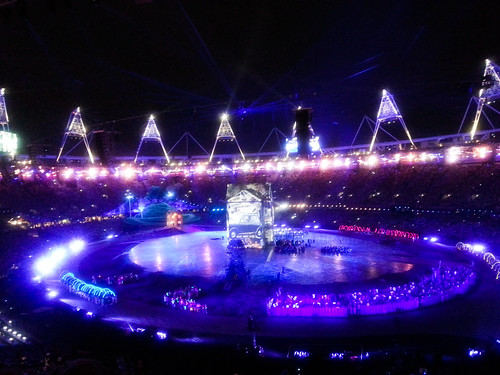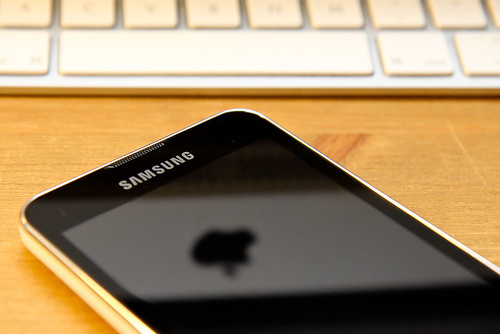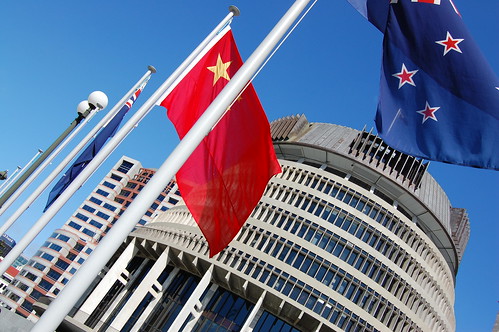
Thanks to
Allan Main, Principal of
MAINly Consulting Ltd for this guest post.
Like everyone else during the past two weeks, I spent an irrational amount of time in front of the television watching the pageant that was the Olympic Games. It has been an immensely colourful spectacle brilliantly aligned to the vibrancy of HDTV, as I am sure was the prime intention rather than to provide those in the arena with a theatrical experience.
Of course we're used to the Olympics parading the exuberance of national colours, but this time there was a flood of colour in the surroundings too. Throughout the venues there was a vibrant constancy in the livery, and one colour seemed dominant. It was present on the crowd barrier surrounding the track, the seats on which the field event athletes rested between turns, on-field drink trolleys, and most of the essential event paraphernalia were thus dressed. Competitor bibs were framed by it, even the sensor-strip on the jump line at the jumping pit was this colour. Come the medal ceremony, female medal escorts were dressed in it, the winners' dais was draped in it and the medals themselves were supported by a ribbon of it. What is “it”; why the colour purple of course.
Nothing extreme or unusual about this; consistent trade dress is a key element of sound branding, and “THE OLYMPICS” mark certainly warrants that dilligence given it is considered (by multinational intangibles valuation consultancy Brand Finance) to be this year's second-most valuable global brand (after APPLE®).
Regularly my television cut to a commercial break, and to a series of advertisements framed by those of premium Olympic sponsors, those who have invested millions – cumulatively US$957mil actually – to have their brands integrally associated with the greatest sporting spectacle in the world. One of these major sponsors was iconic British brand CADBURY®, whose sponsorship allowed them to promote their chocolate as the official confectionery of the 2012 Games. And what was usually first up on the ad break? Why, a smart new TV commercial - a "TVC" - for that very same Cadbury, apparently produced specifically for the games period. A clear intent of this ad is to flourish the fanfare "WE ARE CADBURY AND WE ARE PURPLE!" (well, a specific shade of purple anyway - Pantone 2685C purple).
(Virtual Side Bar: In many jurisdictions around the world, including the United Kingdom and the Australasian nations, Cadbury has been actively moving to register exclusive trademark rights for the specific shade of purple core to their trade dress in as broad an area of the confectionery sector as they can persuade local trademark offices to allow. In prosecuting these applications Cadbury argue with significant success that consumers identify that colour with Cadbury to such an extent that any confectionery wearing that colour is presumed by the consumer to originate from them. As such, they claim to deserve to have the right to exclude competitors from using "their" colour to the same extent that they can exclude others from using their trade name. As these claims become allowed Cadbury's promotions slant ever more to tie the colour purple to their brand.)
At this point the bronze penny dropped - this Cadbury TVC founds on the same colour we have been bombarded by every second of the Olympic broadcast. How “fortuitous” is that!?! (Do I sense a Tui-style “Yeah, Right” repost?)
All Olympic performance spaces are, by IOC edict, product-placement-free (ie "absent", not "at zero cost", of course) zones. Yet the London Organising Committee of the Olympic Games (LOCOG) have clearly skirted that edict in at least one other instance, with the radio-controlled model cars running around the athletics field retrieving and returning field event hardware (discuss, javelins etc) bearing an uncanny resemblance to the current Mini, also as British in its origins as Cadbury. Other than the distinctive shape, there is no branding that makes it clear that this is a Mini ... but we all know it is. BMW, the current owner of the Mini marque, and another official sponsor of the 2012 Games, reputedly paid £40mil as their sponsorship contribution. The “generic” model car discuss-toter’s indisputable resemblance to the Mini we can buy from the local BMW dealer might be construed as part of their reward package for that generous financial support.
So could it possibly be that Cadbury have accomplished a comparable coup (“achievement” not “a 2-door car”) with LOCOG rewarding Cadbury’s sponsorship by having their master colour so prominent in the Olympic livery? The official line is that purple was ACTUALLY chosen to honour Queen Elizabeth's jubilee year - "royal purple" so to speak. As entirely plausible as that is, an alternative construct is that the event sponsor that OWNS purple in confectionery was able to negotiate their rewards to reach into the London Olympics’ trade dress as part of their sponsorship package. You would no more expect that to be publicly announced than was the secret-squirrel BMW-Mini deal, and a pervasive colour is substantially more challenging to unmask, and more subliminal in its effect than is the physical shape of a model car.
On the other hand, perhaps it was just a happy (for Cadbury) coincidence turned by them into a masterful moment of reverse ambush marketing. But however it came about, Cadbury had a greater "virtual presence" at the 2012 Olympic Games than had any other commercial party. After all, where next can you go for greater Olympic brand association once you have connected your brand with the medals that hang around the winners' necks?
I remain in total awe!
All this, whether schemed or serendipity, was enabled by Cadbury's long-term intellectual property management nouse, first to build their colour strongly into their brand identity, then to protect that position by registering it and finally to create a clever association marketing campaign. The cleverest advertising is when you don't even know it is being done to you, except at a subliminal level.
Hats off to Cadbury for seizing the opportunity, however it came about.
Photo courtesy of author Duncan Rawlinson under Creative Commons licence.
 Last year I commented that my AJ Park colleagues and I made submissions on the Samoa Intellectual Property Bill 2011. We met with the Deputy-Registrar responsible for administering the Samoan Intellectual Property Registry.
Last year I commented that my AJ Park colleagues and I made submissions on the Samoa Intellectual Property Bill 2011. We met with the Deputy-Registrar responsible for administering the Samoan Intellectual Property Registry.






